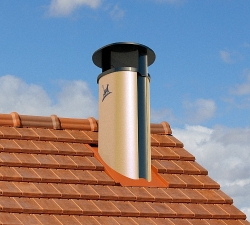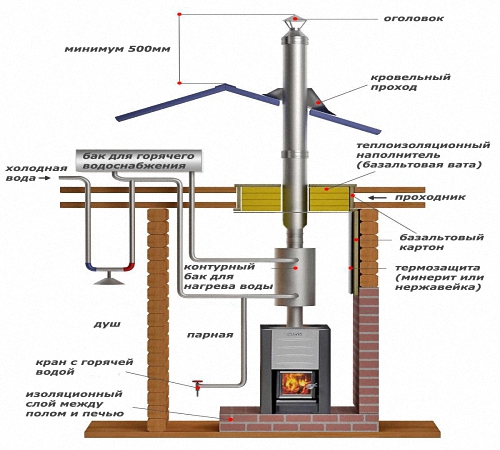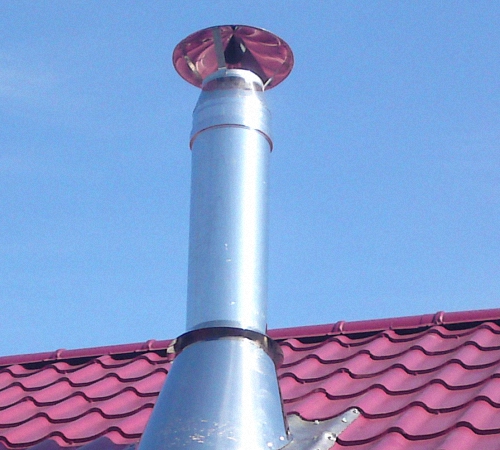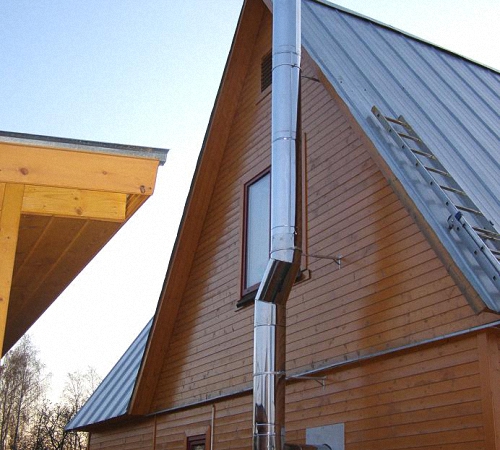The active development of technology allows today to create unique construction ...
|
|
Beauty and reliability are the basic requirements that consumers make ... |
During a thunderstorm, in order to improve the safety of home and people who live there, ... |
Installation of stainless chimneys: step -by -step instructions

Today, the installation of a stainless steel chimney is becoming more familiar than brickwork for the removal of combustion products from a residential building. The popularity of prefabricated structural structures made of stainless steel, including chimneys, is explained by simplicity of assembly, reliability and a long service life. For their production, only high -quality chrome material, steel sheets and galvanizing are used, as well as alloys with various percentage of metals, known for increased resistance to external influences of the environment.
Table of contents:
- The main parameters of stainless chimneys
- What metal is used for chimneys
- Basic elements and their characteristics
- Installation of stainless steel chimney
- The insulation of the chimney
The main parameters of stainless chimneys
In the modern construction market, stainless steel chimneys and various other alloys are presented in a large assortment, and all of them meet the basic operational requirements. There are chimneys for various types of boilers:
- diesel;
- gas;
- solid fuel;
- combined type;
- universal.

Metal chimneys vary in shape:
- straight;
- telescopic;
- stainless sandwich chimneys;
- corrugated flexible stainless chimneys.
The quality of installation not only affects the rapid formation of stable traction, but also on the efficiency of the boiler and the safety of the residents of the house. Do not forget that in the process of combustion, depending on the type of fuel, not only heat is released, but also:
- smoke;
- soot;
- volatile acidic compounds;
- gaseous combustion products;
- carbon monoxide;
- flying resins;
- ammonia and other compounds.
In order to protect yourself and your loved ones from any troubles, it is important to make sure that all these harmful volatile compounds are excreted through the chimney, especially carbon monoxide or COs. When installing stainless chimneys, it is no less important to observe all safety measures and legislative norms. They are set out in specialized literature and legislative acts.
The essence of these norms boils down to the fact that the correspondence of the cross -section of the boiler power, the height of the chimney is more than 5 m, and it is excreted above the roof level to avoid twisting and reverse traction. And the chimney canal should have a minimum of turns and broken segments. The sizes of stainless steel chimneys are originally taken into account by manufacturers, so industrial production is taking into account these norms.

Basic requirements for the chimney:
- a smooth surface and a rounded shape contribute to a stable thrust;
- the formation of condensate is minimal;
- high indicators of heat resistance and tightness;
- simplicity of installation and maintenance;
- fire resistance and safety.
However, all these advantages can only be guaranteed if all the design recommendations are observed, which are divided by experts of stainless steel chimneys: video.
Attention: When buying stainless chimneys of a modular type, be sure to thoroughly study that section in the instructions where it is about its correspondence of the power for which the boiler or stove is designed!
In addition to competent installation, the accessibility to the chimney for cleaning and maintenance, as well as the removal of condensate, for which a separate pipe is no less important.

Flexible stainless chimneys significantly facilitate the installation of an autonomous heating system, especially if it is impossible to observe the direct trajectory of the smoke eating system. Corpushes are effective at high temperature, up to 900C, working on fuel oil, and is also not afraid of temperature changes and quickly warms up by ensuring stable traction when starting the boiler. The main details of the prefabricated design are similar, but the chimney pipe itself is different.
In brickwork, quite wide channels of the ellipse -shaped section are sometimes used, that is, with an oval cross section. Their shape also does not contribute to the accumulation of soot and smoke from reverse traction.
Also produced:
- single-circuit or single-walled chimneys, the so-called mono-systems (a chimney without insulation), which withstand the temperature within 450C, applicable inside the structure, including corrugations;
- double -circuit thermal systems (with a double or triple layer of chimney) on a basalt wool insulation between metal.
There is also the possibility of additional insulation of a stainless chimney, which will be discussed in the last section of the article. But it will be required only for external structures.

The quality of the smoke exhaust system also affects:
1. The thickness of the walls that are designed and fixed in the standards:
- in gas boilers, the thickness of the chimney channel ranges from 0.5 mm,
- on diesel fuel from 0.8 mm;
- in solid fuel boilers from 1 mm.
2. Configuration. The ideal chimney is straight, and the fewer bends, turns and protrusions, the more effective the thrust and less than the clusters of soot. The smooth cylindrical pipe of the chimney of sufficient section contributes to effective operation.
3. The proportions of the diameter (section), the length of the pipe or the height of the chimney provide sufficient traction. Stainless steel chimneys with a smaller diameter than necessary for normal operation reduce the efficiency of a boiler, fireplace or furnace. Experts also argue that it should rise above the upper point of the roof by at least 20 cm, and the chimney itself is no shorter than 5 m.
Special details solve problems with its maintenance:
- revision with soot cleaning;
- condensate removal;
- air fence for the combustion process;
- smoke for protection against precipitation.

What metal is used for chimneys
A stainless steel is called a group of alloys based on steel with a small chromium content or galvanized sheet iron is more correct than galvanizing. Such products are distinguished by excellent anti -corrosion characteristics when interacting with oxygen, water and an aggressive medium of acidic compounds secreted during combustion. This provides spraying into several microns from chromium oxides, so the process is called chromium.
For chimneys, steel of different brands is used:
- 430 covers and other parts for a low aggressive environment;
- 409 contains titanium, go to the pipes of fireplaces, solid fuel boilers and furnaces;
- 316 with the addition of nickel and molybdenum for heat resistance and counteracting acidic compounds in diesel furnaces;
- 304 with the same additives, but in smaller quantities for less aggressive environments;
- 321 universal brand for chimneys of increased heat resistance, up to 850C;
- 310 The most heat -resistant, durable and durable chimneys for the most powerful heating equipment.
Attention: for multi-layer sandwich tube, steel of different brands is used. On the inner table is more persistent and heat -resistant, on external cheaper and easier, so externally looks not as impressive as a single -layer chimney.

Basic elements and their characteristics
The chimney consists of several elements that I have a different purpose and assembly order:
- tee;
- pipe knee;
- revision;
- collection of condensate.
1. The main element is a long straight pipe of the chimney of different lengths, and its fragments are connected by the type of bell without special fastening.
2. The inclined knee (at an angle of 45) connects 2 pipes, changing the inclination of the chimney, and it is used at the junction of horizontal and vertical fragments.
3. The universal knee (at an angle of 90) is also used in the form of a rotary element to change the chimney configuration. Several these elements are used on the entire chimney from the top to the junction of the boiler pipe.
4. The tee of the chimneys are removed into the chimney and cut off condensate. They are also joined in a tributary way or one-in-one.
5. The removal of condensate is placed under the tee to remove excess fluid.
6. The audit is an open element that is designed to clean the smoke exhaust. Mounted under the tee at the base of the vertical barrel drawing:

Installation of stainless steel chimney
Modular chimneys today are most widely used, due to the simplicity of the assembly. This principle makes it possible not to waste time on laborious fastening and sealing of the chimney. Moreover, how vast the choice of details for the assembly of stainless chimneys is the opportunity to vary the configuration as much as possible without damage to the thrust and work of the boilers. Sometimes you can not do without corrugation or several knees in order to competently build a chimney with a minimum reconstruction of the walls.
1. Preparation for installation implies calculations on the proposed chimney configuration, preliminary sketch and marking of the walls along which its fastening is planned. This will most accurately calculate the overall length of the structure and choose the necessary rotary parts for the joint of the pipe.
Attention: Do not forget to add the outer area, which should be at least 25-50 cm above the level of the roof skate to ensure traction in any weather.
2. Before assembling the chimney inside the pipe, the seams are supposed to be treated with a special sealant, which guarantees maximum effectiveness of joints. The outer and outer walls do not require this.
3. Proper installation of the chimney is made from the boiler or furnace, that is, from the bottom up, sequentially joining all the knees and links of the pipe. Drinking according to the type of bell when the upper pipe is inserted into the lower into a special latch. If it is not, but the depth of the shrinkage is almost half of the external diameter.

4. The links at the junction should be securely recorded by the clamps that are attached to the kit. The finished pipe should be attached to the wall or the supporting structures with an interval of one and a half to two meters, and individual brackets are used for installation of bends and tees.
Attention: make sure that horizontal areas and knees do not lie on communication. Fragments should not come in contact with gas pipes and electrical wiring!
As you can see, stainless chimneys began to make with their own hands quite simply. To do this, you need 2 pairs of workers and 1-2 days of time. If there are still questions, watch the video on the installation of the chimney:
Tip: make sure that the condensate does not go past the pipes, falling on isolation and insulation. Also thoroughly process the joints with sealant. The chimney is important to correctly remove through the roof, as described in more detail in the previous article.
The insulation of the chimney
This is one of the important stages when completing the construction of the chimney. Without insulation, which is provided only for chimneys of a stainless steel sandwich, installation will have disadvantages. With a slightly insulated chimney, it is problematic to ensure stable traction when starting the boiler or ignition of the fireplace. And its rapid cooling reduces the overall indicator of the efficiency of the entire autonomous heating system. In addition, condensate, formed on metal walls with the difference in the temperature of the external and internal, gradually destroys the internal walls of the chimney and reduces the effectiveness of its operation.

The design like Sentwitch today is very popular in the installation and insulation of the chimney for modern boilers:
- universal;
- solid fuel;
- gas;
- combined.
They function in intervals mode, that is, stop start. Solid fuel boilers require the durability of fuel and cleaning ash, so they turn off for some time. And constantly working boilers when reaching the required temperature when the sensor or relay is triggered, they turn off on their own to avoid overheating. When the temperature regime in the room is lowered to a given mark, the automatic turning on the heating also works automatically.
During the sleeping mode, the temperature also drops in the chimney, the difference is formed outside and in the chimney nuts, and condensate falls. With the debt heating of the boiler, he slows down the operation of the heating system, which leads to the overspending of fuel.
As a heater, a mineral filler basalt wool is used, which is known for excellent refractory parameters. It is wrapped in layers and wire and/or clamps with her pipe fixed such a blanket. These materials are not afraid of high temperatures, so the chimney can operate on any type of fuel, warming up to 1000c. However, basalt cotton wool needs to be isolated from excess moisture, since damp reduces the effectiveness of insulation.

For waterproofing, galvanizing or stainless steel is used, which is mounted on top of the finished blanket with self -tapping screws. To manage such work, scissors for metal and work skills will be required. But such caps of the required diameter is easier in a specialized workshop to order ready -made ones. And at home there will be no problems in order to complete the final stage of insulation.
Attention: at the end of the installation, the top of the pipe is necessarily fixed so that it does not demolish with a strong gust of wind or tornado. At the top, a smoke is necessarily mounted that protects the entire system from the penetration of precipitation.

My work is connected with
My work is related to construction, a stainless pipe is often needed. I always contact the company "Steel- pro" http://www.steel-pro.ru/trubi/truba-nerzhaveuschaya/. Always delivery in time, the prices are low. I am always satisfied with our cooperation.